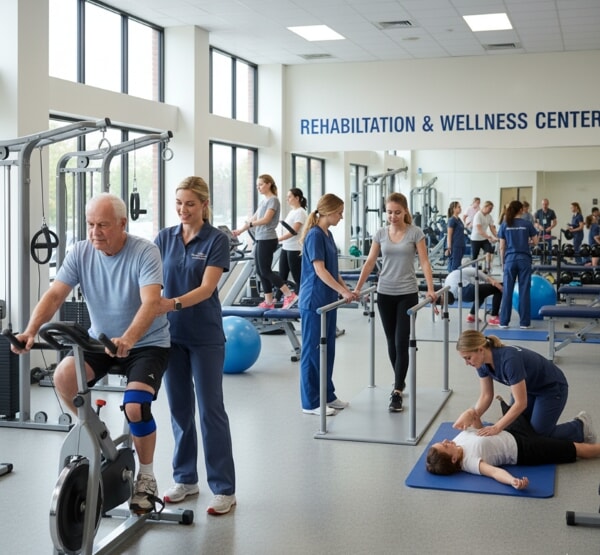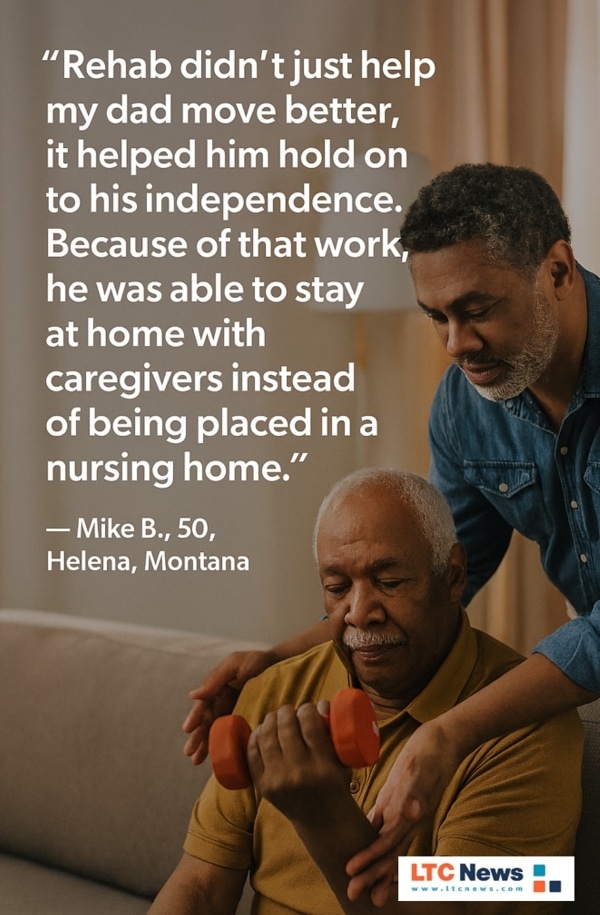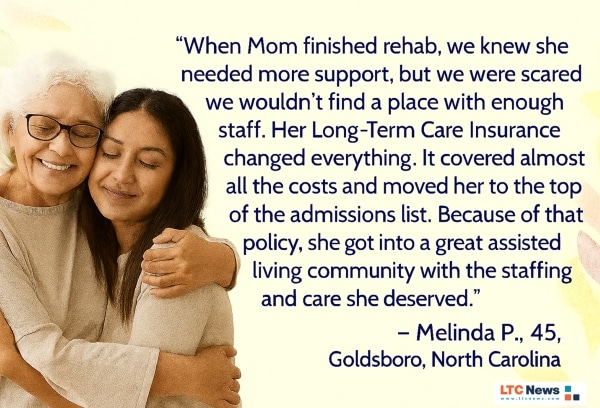Physical Therapy or Physical Rehabilitation? Why Knowing the Difference Helps You Age Safely

Table of Contents
- What Physical Therapy Really Means
- What Physical Rehabilitation Includes
- How Physical Therapy and Rehabilitation Differ
- Why This Distinction Matters as You Age
- What Science Shows About Recovery for Older Adults
- When You Should Choose Physical Therapy
- When Full Rehabilitation Is the Better Choice
- What This Means for Long-Term Care Planning
- Step Toward a Safer, Stronger Recovery
You want to stay independent as you age, but recovering from illness, surgery, or an injury can feel overwhelming. You may hear terms like physical therapy and physical rehabilitation used as if they mean the same thing.
They don’t. And knowing the difference can help you regain strength, avoid setbacks, and maintain the mobility you count on every day.
For adults 50 and older and their adult children, understanding these two care paths is essential for safety and long-term well-being.
What Physical Therapy Really Means
Physical therapy is a specialized, hands-on treatment focused on restoring movement after an injury or medical event. It centers on specific goals and hands-on techniques that help you regain strength and mobility.
Physical therapists guide you through carefully structured exercises and manual therapies to reduce pain, improve balance, and increase joint function.
It is often used for:
- Post-surgical recovery
- Balance and fall-risk issues
- Joint stiffness
- Muscle weakness
- Arthritis and osteoporosis symptoms
- Low back, hip, or knee pain
For many older adults, physical therapy builds confidence for daily life, from getting out of a chair to climbing stairs to walking safely without fear of falling.
What Physical Rehabilitation Includes
Physical rehabilitation encompasses a broader, more holistic approach. Physical therapy may be one part of it, but rehabilitation programs consider the whole person — physical, cognitive, emotional, and functional needs.
A rehabilitation plan often includes:
- Physical therapy
- Occupational therapy
- Speech-language therapy
- Cognitive retraining
- Fall prevention and safety training
- Activities of daily living (ADLs) support
- Care coordination and wellness education
Rehabilitation is typically recommended after major medical events, such as a stroke, joint replacement, heart event, long hospitalization, or injury that affects multiple parts of daily life.
Its goal is not only to improve mobility but to help you return to living independently and to prevent reinjury.
How Physical Therapy and Rehabilitation Differ
The difference is scope.
Physical therapy
Focuses on one area — such as strengthening your leg after knee surgery.
Physical rehabilitation
Supports overall recovery — ensuring you can walk safely, manage daily tasks, prevent falls, and return to your normal life.
Here’s an example.
After a hip replacement, physical therapy helps restore range of motion and strength. Rehabilitation, however, ensures you can navigate stairs, get in and out of the shower, manage your medications, and maintain long-term stability.
Both are essential, but they serve different needs at different stages of recovery.
Why This Distinction Matters as You Age
Aging changes how your body heals. Your reflexes slow. Muscles weaken faster. Falls become more dangerous. Chronic illness affects recovery more than it did decades earlier.
Older adults often face slower healing, slower reflexes, and a higher risk of falls or complications after injuries or surgery. Choosing the wrong level of care can delay healing or lead to reinjury.
Understanding the difference between physical therapy and rehabilitation helps you:
- Heal fully instead of partially
- Improve balance and strength
- Reduce the risk of future falls
- Avoid unnecessary hospitalizations
- Maintain independence at home
- Delay or prevent the need for long-term care
Families and caregivers should advocate for the right level of recovery care, especially when a loved one shows fatigue, mobility challenges, or slower healing after surgery or illness.
What Science Shows About Recovery for Older Adults
Research consistently shows that early, high-quality physical therapy and rehabilitation improve outcomes for aging adults.
Physical therapy benefits
According to the American Physical Therapy Association (APTA), physical therapy reduces pain, can improve strength and mobility to help them regain their range of movement, and helps prevent avoidable disability in older adults. Evidence shows that exercise-based PT lowers fall risk and improves balance and strength.
Rehabilitation benefits
A 2025 review from the American Occupational Therapy Association (AOTA) found that coordinated rehabilitation reduces readmissions and improves independence after major health events. Physical rehabilitation can help you regain your previous movement levels after a major medical event, as it involves a holistic approach to care.
After stroke
A 2025 study published in Neurology and Aging found that multidisciplinary rehabilitation could heighten gait control, balance, and overall independence in stroke survivors, though long-term conclusions require continued research.
The science is clear: consistent, coordinated movement therapy dramatically improves function for older adults.

Share your thoughts and experiences about aging, caregiving, health, retirement, and long-term care with LTC News —Contact LTC News.
When You Should Choose Physical Therapy
Physical therapy is typically recommended when you have:
- A recent injury
- Surgery on a knee, hip, shoulder, or spine
- Localized pain
- Joint swelling or stiffness
- Back or neck issues
- Mild balance challenges
- A chronic condition affecting one body part
It’s ideal when the main goal is to improve mobility or reduce pain in a specific region.
When Full Rehabilitation Is the Better Choice
Rehabilitation is needed when recovery affects your entire life, not just one joint or muscle.
Choose rehabilitation if you are recovering from:
- A stroke
- A fall with multiple injuries
- Joint replacement
- Heart event or cardiac surgery
- Long hospitalization
- General decline or frailty
- Cognitive or neurological changes
Rehabilitation ensures you regain essential skills for independence, such as bathing, dressing, cooking, and navigating safely at home.
The bottom line is clear. Physical therapy is most effective for recent injuries, post-surgical recovery, or localized pain, such as knee, hip, or back issues.
Rehabilitation is more appropriate for comprehensive recovery after major health events, including strokes, joint replacements, or prolonged hospitalizations. The two approaches can overlap in multiple instances, with physical therapy forming a crucial component of a broader rehabilitation program.
What This Means for Long-Term Care Planning
Aging increases the risk of mobility loss, and mobility loss is one of the biggest triggers of the need for long-term care services.
When you need help with Activities of Daily Living (ADLs) such as bathing, dressing, or transferring, this meets the federal definition of needing long-term care. According to the U.S. Department of Health and Human Services, 56 percent of Americans will need long-term care at some point.
Physical therapy and rehabilitation can delay or reduce the need for long-term care, but they cannot eliminate the risk. Often, a care recipient will need physical therapy or rehabilitation over a period of time while receiving help with everyday living activities.
Health insurance and Medicare cover only a minimal amount of skilled care, including physical therapy and rehabilitation. After that, you are out of pocket unless you have Long-Term Care Insurance.
If you have Long-Term Care Insurance, your policy can pay for:
- In-home physical therapy (beyond the short-term coverage provided by health insurance or Medicare)
- Rehabilitation services
- Assisted living or skilled rehabilitation care
- Home modifications and equipment
If your loved one already has an LTC policy, share that with the rehab center or home health agency. It often moves your family member to the top of the admissions list, giving them access to better care options when staffing is tight.

Long-term care services, including skilled services, are expensive, and those costs increase every year.
For current long-term care costs in your state, use the LTC News Cost of Care Calculator and search for extended care costs where you live.
You can also search for quality in-home caregivers and long-term care facilities, including rehabilitation facilities, anywhere in the U.S., using the LTC News Caregiver Directory.
Step Toward a Safer, Stronger Recovery
Knowing whether you need physical therapy or full rehabilitation helps you avoid setbacks and stay independent longer. With the right program, supportive caregivers, and consistent follow-through, you can regain strength, improve balance, and maintain the mobility you depend on.
The more you understand about recovery, the easier it becomes to make confident decisions about your health — and your future.


